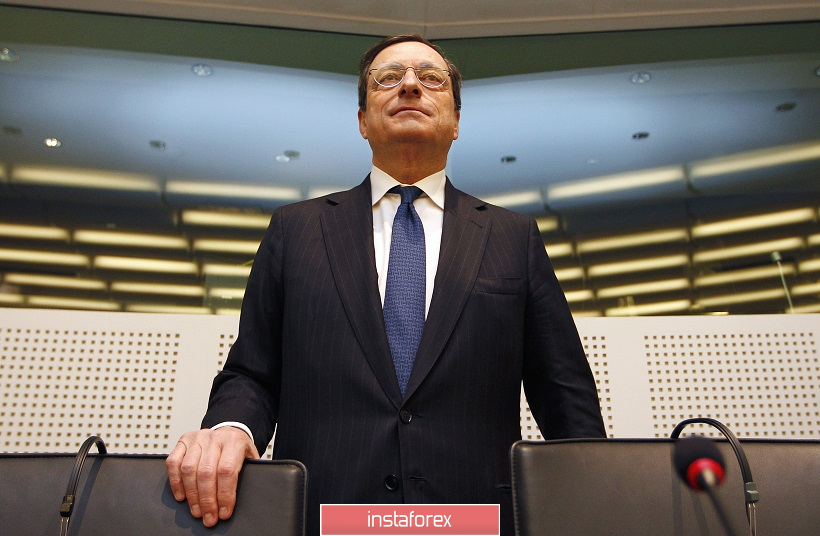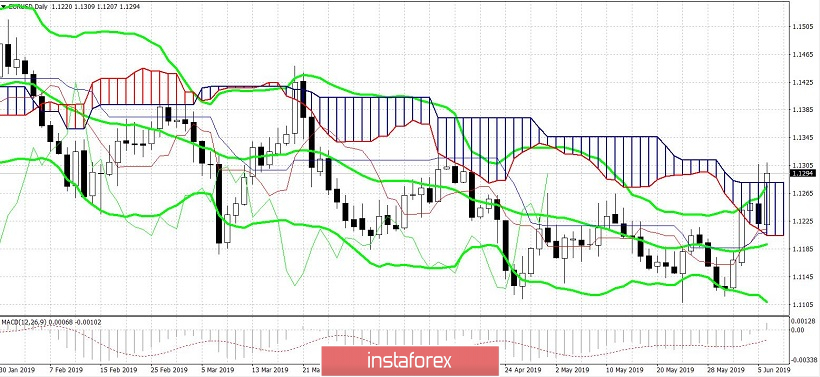Mario Draghi again disappointed - but not the eur/usd bulls this time, on the contrary it was the bears. The head of the ECB voiced a rather reserved position, maintaining the appropriate balance in his rhetoric. Sellers of the euro-dollar pair, in turn, became the victims of their own high expectations. Judging by previous forecasts, the head of the ECB should have hinted at the resumption of QE and allowed the reduction of interest rates, incidentally trimming the forecasts for GDP growth and inflation. But Mario Draghi only partially met the demands of the market, after which the euro-dollar pair again attempted to assault the 13th figure. Like yesterday, this attempt failed, although traders of the pair still show a bullish attitude. The June meeting of the ECB helped the euro to stay afloat, despite the fact that many of Draghi's remarks were clearly not in favor of the single currency.

The main result of today's ECB meeting is that the regulator outlined the algorithms of the baseline scenario and the conditional "plan B". If the first option provides for an increase in the interest rate (albeit not earlier than the second half of 2020), then the second scenario includes the implementation of a set of incentives, ranging from a reduction in the rate and ending with the resumption of QE (or vice versa). Having distinguished between these scenarios, Draghi made it clear that the European Central Bank adheres to the baseline scenario, expecting the growth of inflation indicators and other key economic indicators. This, in fact, is due to the pair's current momentum towards the bottom of the 13th figure. Naturally, the head of the ECB did not rule out that the regulator may have to resort to the implementation of the "plan B", using every available tool to stimulate the economy. However, the current situation in the eurozone economy, according to Draghi, allows you to maintain a wait-and-see position.
The position voiced by the head of the ECB was contrary to the expectations of many experts who were confident that the regulator was announcing easing monetary policy. Some central banks of the leading countries of the world have already taken concrete steps in this direction, for example, the Reserve Bank of Australia, the Reserve Bank of New Zealand, the central bank of India. But Draghi decided not to join this "club" so far, as a result of which the pair has shot upwards.
But the eur/usd bulls failed to linger within the 13th figure. The single currency still has no strength for its own growth, so it is still focused on the dollar, which, in turn, has frozen in anticipation of tomorrow's Nonfarms. Mario Draghi helped the euro so that it would not plummet in the entire market, but could not boost the currency, because, in addition to optimistic estimates, the head of the ECB also voiced quite unfavorable nuances.
First, the European Central Bank revised its forecast for GDP growth this year to the downside - from 1.6% to 1.4%. The regulator made a similar decision relative to 2021, lowering the estimate of economic growth from 1.5% to 1.4%. At the same time, Draghi noted that downside risks continue to prevail, including in relation to inflationary processes. According to the ECB, the general indicator of inflation will decline in the coming months, although at the end of the year it will show a positive trend. The same applies to core inflation - the core consumer price index will be under pressure for the next quarter, but will then give "signs of life." In general, the inflation forecast for this year was revised from 1.2% to 1.3%, and for 2020 - from 1.5% to 1.4%.
Thus, the European Central Bank made it possible for the eur/usd pair to continue to show character today. Contrary to the expectations of many experts, Draghi did not pull down the euro, after which the corrective price increase resumed. At the same time, bulls of the pair do not succumb to the 13th level, the "conquest" of which in the future will open the way to 14-15 figures. In this context, the Nonfarms will be the key that will largely determine the fate of the dollar tomorrow. If the official figures are similar to the data of the ADP agency (the report showed an increase in the number of people employed by only 27 thousand), then it will be the third opportunity for buyers of the eur/usd pair to gain a foothold in the 13th figure.

In technical point of view, the situation is as follows. On the daily chart, the euro-dollar has crossed the upper line of the Bollinger Bands indicator and the upper limit of the Kumo cloud. The Ichimoku trend indicator has formed a bullish Parade of Lines signal, which warns of a high probability of further price growth. To determine the nearest resistance level, let's move to a weekly chart. On this timeframe, the price can meet resistance only at the 1.1335 mark, that is, on the Kijun-sen line on W1. When overcoming this target, the price can go to the main resistance level - the mark of 1.1450 - this is the upper line of the Bollinger Bands indicator, which coincides with the lower boundary of the Kumo cloud on the weekly chart. On the one hand, such price peaks look unattainable - but if tomorrow's Nonfarms disappoints the market, eur/usd buyers can quickly bring the pair to the specified levels.










